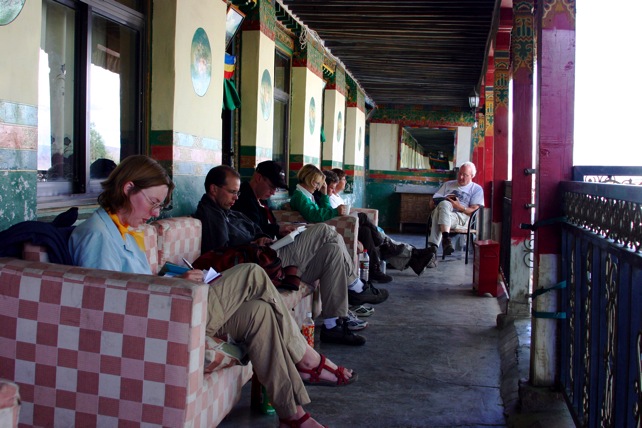


Sakya - Lhatse

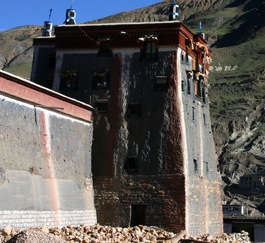 September 2 – to Lhatse via Sakya Monastery
September 2 – to Lhatse via Sakya MonasterySakya was going to be our last monastery, and it was going to be special. After driving from Shigatse almost to Lhatse, we took a side road and drove the 25 km needed to reach Sakya.
The monastery looks more like a fort than a religious institution from the outside: A square surrounded by thick walls with a turret on each corner. Characteristic for the monastery are vertical red and blue stripes. After Sakya until the border we saw many houses with the same stripes indicating they were faithful to the Sakya sect.
Inside the keep were the now familiar buildings of a Buddhist monastery. In the first building we entered, a small assembly hall, the monks were just setting up a sand mandala: In a glass cube, a monk was busy outlining the mandala. While we were looking, many monks filed in and started their prayers. Interestingly, these prayers were not the guttural murmurs we had heard before, but more higher pitched singing. While the monks were praying, the mandala outliner finished his work by putting one pinch of sand in the middle of the circle.
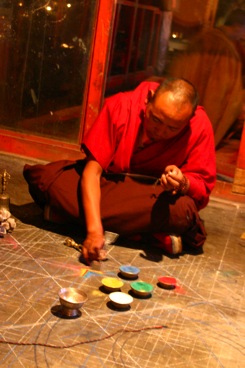
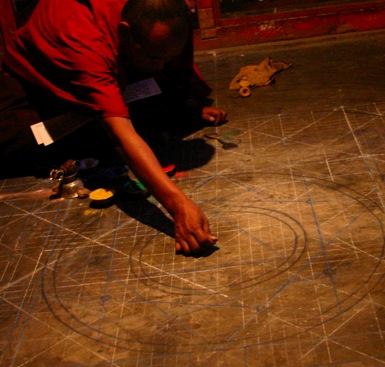
The mandala outliner left the glass cube, but soon afterwards five monks went in, and after some debate and prayer they started the work with a red triangle. They used only their fingers 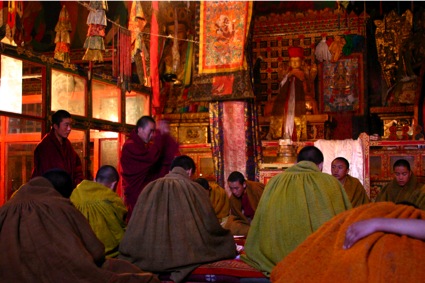 to put down the sand, but had spatulas and other small tools to make corrections. Although Dawa wanted to continue the tour, some of us couldn’t keep our eyes off the mandala crew, and stayed behind to watch the mesmerizing process.
to put down the sand, but had spatulas and other small tools to make corrections. Although Dawa wanted to continue the tour, some of us couldn’t keep our eyes off the mandala crew, and stayed behind to watch the mesmerizing process.
 to put down the sand, but had spatulas and other small tools to make corrections. Although Dawa wanted to continue the tour, some of us couldn’t keep our eyes off the mandala crew, and stayed behind to watch the mesmerizing process.
to put down the sand, but had spatulas and other small tools to make corrections. Although Dawa wanted to continue the tour, some of us couldn’t keep our eyes off the mandala crew, and stayed behind to watch the mesmerizing process.At some point we had to leave for lunch, but after lunch we sneaked back to see they had made quite some progress, although they still had a long way to go to finish it.
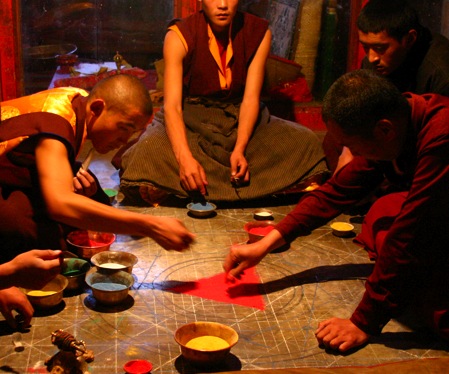 I noticed one thing when we visited the monasteries: A certain erotic appeal of these monks. Their life strikes me as very beautiful (probably a projection/ selective attention). A key scene was the construction of a sand mandala by a group of monks we observed at Sakya monastery. The monks sat in a glass cube and discussed scriptures before laying out the mandala, first by drawing its lines on the floor, then by placing bowls of colored sand in certain places (line intersections).
I noticed one thing when we visited the monasteries: A certain erotic appeal of these monks. Their life strikes me as very beautiful (probably a projection/ selective attention). A key scene was the construction of a sand mandala by a group of monks we observed at Sakya monastery. The monks sat in a glass cube and discussed scriptures before laying out the mandala, first by drawing its lines on the floor, then by placing bowls of colored sand in certain places (line intersections). 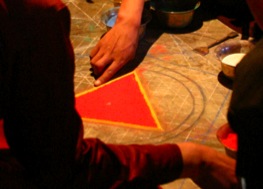 After a while, each of them (there were four, with one “helper” switching between them) began working in earnest, each at one of the four cardinal directions. They poured sand through fine pipes or used their fingers, making intricate patterns. All the while, other monks chanted a very different song with a simple melody, reminiscent of a
After a while, each of them (there were four, with one “helper” switching between them) began working in earnest, each at one of the four cardinal directions. They poured sand through fine pipes or used their fingers, making intricate patterns. All the while, other monks chanted a very different song with a simple melody, reminiscent of a 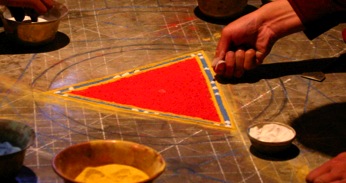 church hymn. The mandala monks were so focused on their task, their faces almost touched the sand, but occasionally they took a sip of tea and asked each other for a bowl of sand.
church hymn. The mandala monks were so focused on their task, their faces almost touched the sand, but occasionally they took a sip of tea and asked each other for a bowl of sand. 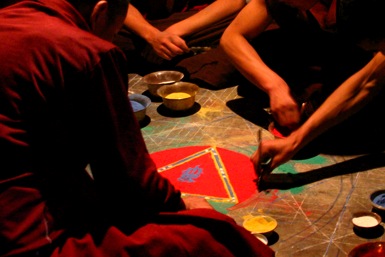 The enormous appeal of this scene, to me, lay in seeing beautiful young men working together on a common purpose – ironic, considering I don’t know the mandala’s symbolism, except that its ultimate fate is to be wiped out again.
The enormous appeal of this scene, to me, lay in seeing beautiful young men working together on a common purpose – ironic, considering I don’t know the mandala’s symbolism, except that its ultimate fate is to be wiped out again.In general, the unselfconscious playfulness and affection of the monks for each other (another group of them sat outside the prayer hall at Shigatse, holding hands) impressed me – these traits impress me outside Buddhist 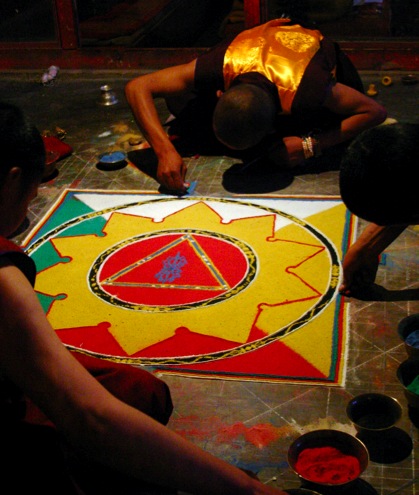 monasteries as well, but it’s rare to observe them in less protected environments.
monasteries as well, but it’s rare to observe them in less protected environments.
 monasteries as well, but it’s rare to observe them in less protected environments.
monasteries as well, but it’s rare to observe them in less protected environments.Maybe this fascination with the monks’ affectionate life together has its roots at the fact that I have no brothers or sisters – the same reason I’m always interested in hearing from Niels about his adventures with his siblings!
At the end of the day we arrived in Lhatse, a small, unspectacular town. The guesthouse we stayed at should be recommended (Lhatse Tibetan Farmer’s Guesthouse), even though it was very primitive without running water in the rooms and with pit-toilets outside. But it had a cheerful owner, and great verandas to sit outside in the evening on student-grade sofas.
